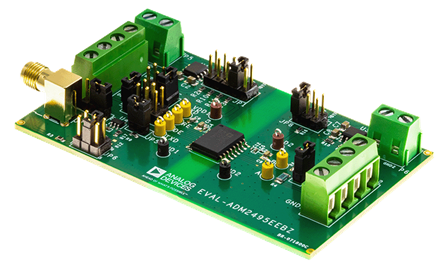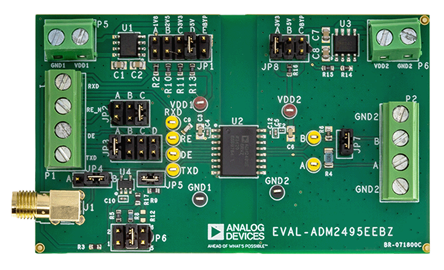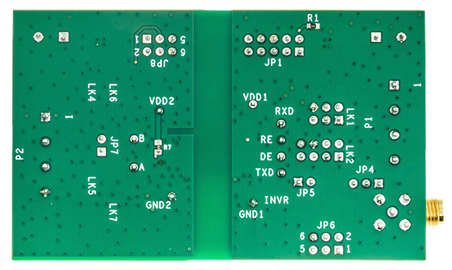Overview
Features and Benefits
- Simplified evaluation of the ADM2495E/ADM2495E-1 250kbps half-duplex isolated RS-485 transceiver
- 2-layer PCB compliant to EN 55032 Class B radiated emissions
- Footprint for 10mm × 10mm, 16-lead SOIC_W package with >8.0mm creepage and clearance
- On-board ADP7104 LDO regulators with jumper options for simplified evaluation in multiple supply configurations
- Flexible, low voltage VDD1 supply rail for interfacing with I/O nodes as low as 1.7V
- IEC 61000-4-2 ESD protection on the A pin and B pin
- ±4kV contact discharge
- SMA connector for TxD input signal
- Optional on-board LTC6900 oscillator for providing TxD signal
- Screw terminal blocks for connecting power, digital, and RS‑485 signals
- Jumper-selectable enable and disable for digital input signals
- Resistors and footprints for termination
- Test points for measuring all signals
Product Details
The EVAL-ADM2495EEBZ allows simplified, efficient evaluation of the ADM2495E 5.7kVRMS, 250kbps half-duplex signal isolated RS-485 transceiver. The EVAL-ADM2495EEBZ can also be used to evaluate the higher speed 20Mbps ADM2495E-1 by replacing the low-speed part with the higher speed part.
The EVAL-ADM2495EEBZ comes with options for the evaluation of the ADM2495E/ADM2495E-1 device in an individual system. Digital and RS-485 bus signals are easily accessible via the screw terminal blocks on the EVAL-ADM2495EEBZ. Each digital input can be configured via the on-board jumper options.
Two on-board ADP7104 low dropout (LDO) regulators accept an input voltage of up to 20V and output a range of selectable supply voltages to the VDD1 and VDD2 pins, configurable via jumper options. The LDO regulators can be bypassed to power theADM2495E/ADM2495E-1 VDD1 and VDD2 supply pins directly from external power supplies.
The flexible VDD1 pin primary side logic supply allows the device to operate with a digital input/output (I/O) voltage from 1.7V to 5.5V, which enables communication with modern processors using either a 1.8V or 2.5V power supply.
Different methods can be used to provide the transmit data input (TxD) data input signal to the device. An optional LTC6900 oscillator is included on the EVAL-ADM2495EEBZ and can be configured to provide a clock signal as the TxD digital input within a 10kHz to 20MHz range. Jumper settings allows frequency selections of 10kHz, 100kHz, 1MHz, 10MHz or TBD based on the value of a customer installed 0603 resistor. Note that frequencies above 125kHz are intended for when the higher speed ADM2495E-1 part is installed. A terminal block allows an easy wired connection to a microcontroller or processor. For optimal signal integrity, use the on-board subminiature version A (SMA) connector to connect an external data signal.
Please see the User Guide for the full description.





